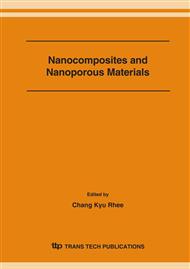p.119
p.123
p.127
p.131
p.135
p.139
p.143
p.147
p.151
Effect of Cooling Rate on Mechanical and Electrical Properties of Cu-TiB2 by Turbulent In-Situ Mixing Process
Abstract:
A copper matrix composite reinforced with in situ TiB2 nanoparticle was successfully fabricated by tubulent in-situ mixing process. The microstructure, mechanical and electrical properties of the in situ composite were investigated. The results showed that the in situ formed TiB2 particles, in which size varying from about 50nm to 200nm, exhibited a homogenous dispersion in the copper matrix. It is shown that the interface between the nanoscale particles and the matrix was clean without a transitional layer. Because of the reinforcement, the hardness and Young’s Modulus of the composite improved with increment of cooling rate. Moreover, the in situ Cu-TiB2 composite exhibited higher electrical conductivity with increasing of cooling rate.
Info:
Periodical:
Pages:
135-138
Citation:
Online since:
January 2007
Authors:
Price:
Сopyright:
© 2007 Trans Tech Publications Ltd. All Rights Reserved
Share:
Citation:


